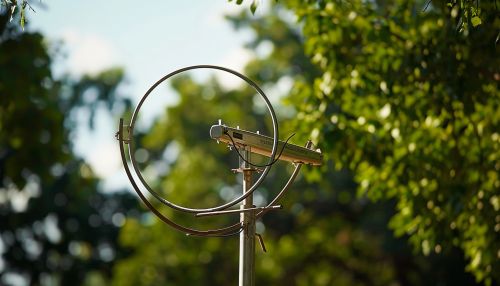Loop antenna
Introduction
A loop antenna is a type of radio antenna that is composed of a loop or coil of wire, tubing, or other electrical conductor usually fed by a balanced source or feeding a balanced load. Within this physical description, there are three distinct antenna types. The large self-resonant loop antenna has a circumference close to one wavelength of the operating frequency and so is resonant at that frequency. The ordinary small loop antenna, or simply loop antenna, is technically defined as having a circumference less than one-tenth of a wavelength. The small loop antenna is often referred to as a magnetic loop. The third category is the loopstick antenna, which is a resonant antenna with a coil that is wound on a magnetic core of a ferrite rod.


Design and Operation
The loop antenna is designed to be small compared to the wavelength of the desired frequency. The loop antenna's main advantage is its directionality. As a result, the loop antenna is mainly used in two areas: for reception in locations with high levels of interference, and for direction finding.
Radiation Mechanism
The radiation mechanism of a loop antenna can be understood by considering the current distribution on the loop. The current in a small loop antenna is nearly constant. The magnetic field, which is perpendicular to the plane of the loop, is therefore also nearly constant in the plane of the loop. The electric field, which is parallel to the plane of the loop, is therefore nearly zero in the plane of the loop. Thus, the loop antenna radiates a magnetic field that is confined to the plane of the loop, and an electric field that radiates away from the plane of the loop.
Polarization
The polarization of a loop antenna is determined by the orientation of the loop. If the loop is vertical, the antenna radiates in the vertical plane and the polarization is vertical. If the loop is horizontal, the antenna radiates in the horizontal plane and the polarization is horizontal.
Directivity
The directivity of a loop antenna is a function of the shape and size of the loop. For a small circular loop, the directivity is maximum in the plane of the loop and minimum in the direction perpendicular to the plane of the loop. For a large loop, the directivity is more complex and depends on the exact shape and size of the loop.
Efficiency
The efficiency of a loop antenna is a function of the resistance of the loop and the frequency of operation. The resistance of the loop is a function of the material and the diameter of the wire or tubing used to construct the loop. The frequency of operation affects the skin depth of the current in the conductor, which in turn affects the resistance of the loop.
Applications
Loop antennas are used in many areas of radio technology. They are used in both transmitting and receiving applications, and are particularly useful in situations where space is limited or when a directional antenna is required.
Radio Direction Finding
One of the main applications of loop antennas is in radio direction finding (RDF). RDF is a method of finding the direction, or bearing, of a radio signal. A loop antenna is ideal for this application because of its directionality.
Low Frequency Reception
Loop antennas are also used for reception of low frequency signals. They are particularly useful in this application because of their ability to reject interference from electrical sources.
Near Field Communication
Loop antennas are used in near field communication (NFC) devices. NFC is a short-range wireless connectivity technology that enables simple and safe two-way interactions between electronic devices.
Radio Astronomy
Loop antennas are used in radio astronomy to detect and measure the radio waves emitted by celestial bodies.
